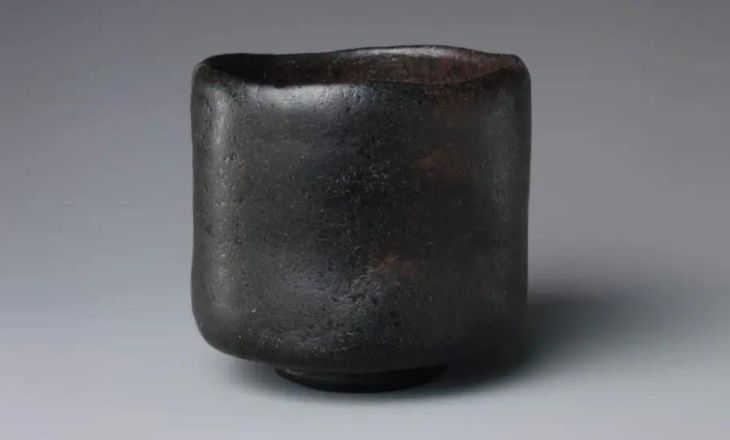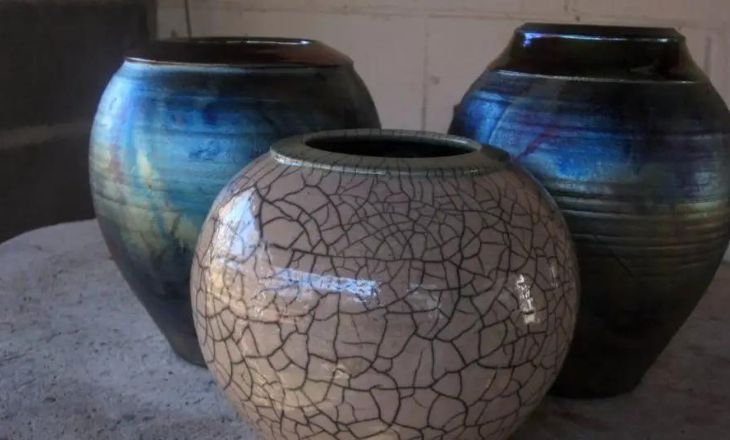Raku pottery involves elements of chance and experimentation, adding an element of excitement for both the artist and the viewer. In modern times, raku has become increasingly popular among artists seeking to break away from traditional ceramic techniques and embrace a more dynamic and spontaneous approach to their craft.
What Is Raku Pottery?
Raku pottery is a unique and captivating form of ceramic art that originated in Japan during the 16th century. The pieces are removed from the kiln when they reach bright red heat, allowing them to cool rapidly in the open air. This rapid cooling results in distinctive crackling patterns and vibrant colors, creating a sense of spontaneity and unpredictability in each piece.
It embraces imperfections as part of its beauty, reflecting the Japanese philosophy of wabi-sabi – finding beauty in impermanence and imperfection.It has become increasingly popular among artists seeking to break away from traditional ceramic techniques and embrace a more dynamic and spontaneous approach to their craft.
History of Raku Ceramics
Raku Ceramics has a rich and intriguing history that dates back to 16th century Japan. The name raku derives from the family who first developed this unique firing technique, and it was initially used for the creation of tea bowls for traditional Japanese tea ceremonies.
The process involves removing the pottery from the kiln at high temperatures and cooling it rapidly, resulting in a distinctive crackled glaze and unpredictable colors, making each piece one-of-a-kind.Raku differs from other ceramic traditions in that it emphasizes the beauty of unplanned events above careful planning.
Raku ceramics are becoming more and more well-known globally as an expressive art form that combines innovation and tradition in the modern period, beyond its cultural roots. Artists of today honor the centuries-old craft of raku ceramics while experimenting with new mediums and pushing limits.
Japanese Tea Ceremonies and Raku Ware
The Japanese tea ceremony, known as chanoyu or sado, is a time-honored tradition that embodies harmony, respect, calm, and cleanliness. it’s a holistic experience that encompasses the entire process of preparing and serving the beverage it wares, often used in Japanese tea ceremonies, which holds its significance in this ancient art form.

For both the host and the guests, the careful movement choreography and calm atmosphere foster a state of attention and concentration that may be immensely fulfilling. By encouraging participants to be present in the moment, this cultural practice helps people connect with others and themselves on a deeper level.
Western Raku Ware
Western raku ware, a modern take on the traditional Japanese ceramic process, has captured the attention of artists and collectors worldwide. Unlike its Eastern counterpart, Western raku pottery often incorporates more vibrant glazes and experimental firing techniques, resulting in captivating colors and patterns.
This departure from tradition has sparked a renaissance in raku ceramics, as artists embrace the spontaneity and unpredictability of this unique firing process.

One aspect that sets Western raku ware apart is its emphasis on individual expression and artistic freedom. Artists are drawn to raku for its ability to produce one-of-a-kind pieces with distinctive surface textures and iridescent hues. This fusion of ancient technique with contemporary aesthetic sensibilities has transformed raku from a niche art form into a dynamic medium for self-expression and innovation.
How to Make Raku Pottery
Creating raku pottery is a deeply engaging and rewarding process that requires patience, creativity, and a willingness to embrace unexpected outcomes. The magic of raku lies in its unpredictable nature; the effects of firing and cooling processes can result in stunning, one-of-a-kind pieces.
To begin, prepare the clay by kneading it thoroughly and shaping it into your desired form. Once the piece has dried, it is bisque-fired to harden it before glazing. Next comes the glaze application, where experimentation with different combinations and techniques can yield diverse and mesmerizing results.
These pieces are then placed in a kiln for a rapid firing session at an extremely high temperature before being removed to cool quickly – this abrupt change creates unique crackling patterns on the surface.
The transformative process of raku fired pottery carries an element of unpredictability that adds an exciting dimension to each creation. During the crucial post-firing stage, where the red-hot ceramics are carefully transferred into combustible material for smoking, vibrant flashes of color emerge in response to atmospheric changes within this environment.
Watching as these colors emerge and shift during this phase underscores how much every aspect – from choice of materials to handling techniques – influences outcome. Each piece tells a story through its aesthetics and journey from raw clay to finished artwork – encapsulating adventure within their very forms.
What Type of Clay is Best?
When choosing the best type of clay, there are several options to consider, each with its unique properties and benefits. Many artists swear by stoneware clay due to its versatility and durability. Stoneware is known for its ability to withstand high temperatures, making it ideal for functional pieces like mugs and dishes.
Its smooth texture allows for detailed carving and intricate designs.On the other hand, porcelain clay is revered for its fine texture and pure white color when fired, making it a popular choice for delicate ceramics and decorative pieces.
Its translucency when thin can create stunning visual effects in lighting fixtures or tea sets. However, porcelain can be more challenging to work with due to its tendency to warp during firing if not handled properly.
Earthenware clay offers a more accessible option for beginners or those looking for a more rustic aesthetic. It’s softer and easier to manipulate than stoneware or porcelain but may not be as durable when used for functional objects. It’s also known for producing vibrant colors when glazed, allowing artists to experiment with bold finishes.
Raku Firing Process
Raku firing, a Japanese pottery technique originating in the 16th century, is more than just a method of ceramic firing – it’s an art form that embodies spontaneity and unpredictability. This process involves removing the pieces from the kiln at high temperatures and placing them directly into combustible materials such as sawdust or leaves, resulting in unique patterns and colors.
The sudden temperature change causes crackling and metallic luster, creating awe-inspiring finishes that are impossible to replicate.This method encourages creativity and experimentation with various combustible materials and glazes to achieve different effects, ensuring that no two raku-fired pieces are ever quite the same.
Raku Kilns
The beauty of Raku kilns lies in their ability to create stunning, unpredictable results. With its roots in Japanese pottery traditions, the Raku firing process brings an element of spontaneity and excitement to the ceramic art world. By removing pieces from the kiln while they are still red hot and placing them into a reduction chamber filled with combustible materials, unique variations, and crackling effects are achieved on the glaze surface.
. The fusion of fire, smoke, and air during the rapid cooling process imparts an ethereal quality to the finished pieces that is impossible to replicate through other firing techniques. This sensory experience adds depth and character to every creation fired in a Raku kiln, making it a captivating choice for artists seeking to infuse emotion and vitality into their work.
Raku Glazes
Raku glazes have a long history of captivating artists with their unique and unpredictable effects. These glazes are known for their vibrant colors and dramatic variations, often resembling metallic lusters or crackled textures. The unpredictable nature of raku firing creates an element of surprise, making each piece truly one-of-a-kind.
One of the key secrets to achieving stunning raku glaze effects lies in mastering the art of reduction. By quickly removing pieces from the kiln and placing them in combustible materials like sawdust or newspaper, artists can induce rapid cooling and oxygen reduction, resulting in iridescent metallic finishes and vivid color bursts.
Combustible Materials for Raku Firing
Raku firing, with its origins in Japan, is known for its unpredictable and dramatic results due to the combustible materials used during the process. The use of sawdust, newspaper, leaves, or other organic matter adds an element of surprise and unique patterns to the pottery. These combustible materials create flashes of color and smoky effects on the glaze as they burn away during the rapid cooling phase.
Experimenting with different types and quantities of combustible materials can lead to varied outcomes in raku firing. This continuous exploration of combustible materials offers artists endless opportunities for creativity and innovation in raku firing.
Is Raku Pottery Food Safe?
Raku pottery is known for its unique and beautiful designs, has raised concerns about its safety for food use. The process of creating Raku involves rapid heating and cooling, which can create potential issues with durability and resistance to moisture.
While many artists use non-toxic glazes that are safe for food, others may not take the same precautions. It’s essential for consumers to carefully research the artist or manufacturer of Raku pottery before using it for serving food.
To ensure the safety of Raku pottery for food use, look for pieces labeled as food-safe or those that explicitly mention being lead-free and designed for culinary purposes. using a protective barrier such as a napkin or dish liner between the pottery and the food.
By being mindful of these factors, consumers can still enjoy the aesthetic appeal of Raku pottery while prioritizing their health and well-being.
Conclusion
Raku pottery is a unique form of ceramic art that originated in Japan and has gained popularity around the world. Its distinctive firing process and emphasis on spontaneity create stunning, one-of-a-kind pieces that captivate both artists and collectors. If you haven’t experienced the beauty of raku pottery firsthand, I encourage you to seek out a local artist or studio to explore this fascinating art form for yourself.
FAQS
What is the Difference Between Raku and Regular Clay?
Raku clay is low-fire, porous, ideal for rapid temperature changes. Regular clay is high-fire, durable, less porous, used for functional pottery.
What is Special About Raku?
Raku pottery, originating in Japan in the 16th century, features spontaneous firing and unique surface patterns.
